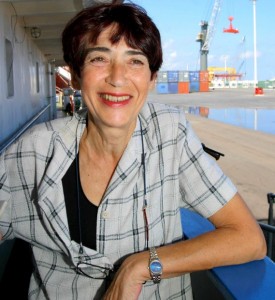Cabo San Antonio
Zelitsky, Paulina
Paulina Zelitsky was born in Poland and studied engineering in the former Soviet  Union. During the Cold War she worked on a submarine base in Cuba but defected to Canada, where she married Paul Weinzweig and together set up a company called (ADC). The company specialises in deep-sea exploration. The Cuban government had employed them to assist in the location of sunken treasure that is believed to lie off the coast in a variety of vessels.
Union. During the Cold War she worked on a submarine base in Cuba but defected to Canada, where she married Paul Weinzweig and together set up a company called (ADC). The company specialises in deep-sea exploration. The Cuban government had employed them to assist in the location of sunken treasure that is believed to lie off the coast in a variety of vessels.
In 2001, they announced the discovery of megalithic structures 9 km off Cabo San Antonio on the western tip of Cuba, in water half a mile deep. The expedition was a joint venture between ADC, the National Geographic Society and the Centre for Marine Archaeology and Anthropology at the Cuban Academy of Sciences in Cuba. Subsequent announcements included a claim that inscriptions had been found on some of stones that appear vaguely similar to Greek. Other carvings seem to be related to Central American symbols including what is sometimes referred to as the Central American Cross. Cuban academics are studying these incisions. It has been suggested that the US State Department applied pressure on The National Geographical Society to withdraw a promise of two million dollars to fund further investigations because of US Administration’s antipathy towards Cuba at that time. Later that year Zelitsky gave an interview to Linda Moulton Howe that can be read online(a).
In late 2004, Zelitsky led a team to explore the sea floor between the Yucatan peninsula and Cuba where sonar reading had suggested manmade structures. Apparently they think that an island was submerged ten or twelve thousand years ago as a result of seismic activity.
May 2013 saw Zeilitsky and Weinzweig attempt to reprise the attention that they received when they first made their claim a dozen years earlier. A recent interview(b) with journalist Luis Mariano Fernandez has Zeilitsky rehashing her original claim with the addition, perhaps by Fernandez, of the old story of a glass pyramid in the Bermuda Triangle touted by the late Ray Brown.
A more critical review of the Zeilitsky-Weinzweig claims is to be found on the Bad Archaeology website(c).
(b) https://wolfke74.wordpress.com/2013/05/31/atlantis-found/
(c) https://badarchaeology.wordpress.com/2012/10/28/an-underwater-city-west-of-cuba/
